|
|
 |
|
 |
|
Nataša Šegota Lah VISUAL ARTS A panoramic survey of visual arts 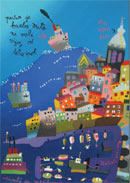 The
Kvarner area abounds in diverse approaches to visual arts that are
characterised by a variety of motifs, sensibilities and historical
sources. Changes throughout history, various cultural influences, and
finally the 20th century as a bridge between the old and the new eras,
have created a varied picture interwoven with scenes from folk and urban
creations in the form of both inherited and newly created cultural
diversity. In this survey, we are interested in locations and traces of
visual arts that comprise painting and sculpture. We will follow the
traces of visual artists in our region, mainly in religious buildings
and public places, and give some insight into the existing collections
of museums and galleries. This will be a walk through the visual
panorama of this region characterised by its green-blue landscape, with
the remark that we will limit our selection only to the most important
works and personalities that are easily accessible to visitors. The
Kvarner area abounds in diverse approaches to visual arts that are
characterised by a variety of motifs, sensibilities and historical
sources. Changes throughout history, various cultural influences, and
finally the 20th century as a bridge between the old and the new eras,
have created a varied picture interwoven with scenes from folk and urban
creations in the form of both inherited and newly created cultural
diversity. In this survey, we are interested in locations and traces of
visual arts that comprise painting and sculpture. We will follow the
traces of visual artists in our region, mainly in religious buildings
and public places, and give some insight into the existing collections
of museums and galleries. This will be a walk through the visual
panorama of this region characterised by its green-blue landscape, with
the remark that we will limit our selection only to the most important
works and personalities that are easily accessible to visitors.Originating from a source of various influences, the culture of this region has been maintained within the bounds of rather modest resources. Today expert and material efforts are being made to appropriately validate the entire artistic production created up to the end of the 20th century, and to open to the public the permanent exhibitions within the existing large museums as soon as possible. Our task is also to re-establish the reputation of some extraordinary historic personalities that were born here, like Julije Klović, a miniaturist of worldwide renown from the Vinodol region. Juraj Julije Klović, born in 1498 in the village of Grižane near Vinodol and died in 1578 in Rome, was one of Europe’s greatest 16th century miniaturists in the period of mannerism. With elongated figured, landscapes of mysterious ambience, pale greenish, bluish and violet tones and luxuriant ornamentation, he depicted the pages of the masterpiece Officium Virginis which contains 28 of his miniatures showing scenes from the Old and New Testaments and two miniatures with liturgical themes. The history of sacred arts in the Kvarner area also encompasses a series of valuable paintings that we inherited over the past centuries as works of masters from abroad, as imported works of arts, or as the creations of rather few indigenous artists. This panoramic survey will mainly concentrate on the collections available to visitors, which means that many valuable painters from our region have been left out because there are no available permanent collections of their work. Among the artists from the beginning of the 20th century, one should not forget Josip Moretti Zajc - Peppo (Bakar 1882 – Rijeka 1933), a painter dedicated to light and influenced by Venetian painting, who created some of the finest Kvarner landscapes, marinas and panoramas, as well as the stage curtain in the Croatian Reading Room (Hrvatska čitaonica) in Trsat. The artists from the Kvarner region who worked in the productive period in the second half of the 20th century and strongly influenced the visual arts of the region were Romolo Venucci (Rijeka, 1903 – 1976), Jakov Smokvina (Rijeka, 1903 – Volosko, 1987), Vladimir Udatny (Voćin, 1920 – Rijeka, 1972), Antun Haller (Split, 1923), Ivo Kalina (Zagreb, 1924 – Rijeka, 1995), Vojo Radoičić (Požega, 1930), Slavko Grčko (Rijeka, 1934), Josip Diminić (Sveti Lovreč, 1937), Mauro Stipanov (Rijeka, 1952) and many others who will be mentioned later in this text. Sculptor Ljubo de Karina from Brseč and painter Mate Solis from Cres are the best examples of visual artists who worked in their places of origin and made a great contribution to the region in which they lived by creating individually shaped houses – museums and receiving recognition by many experts. A special place among artists who dedicated their most valuable work to depicting motifs from the regional landscape belongs to Oton Gliha (academic painter, born in Črnomelj/Slovenia, 1914 – died in Zagreb, 1999) and Mila Kumbatović (academic painter, born in Omišalj, 1915 – died in Zagreb, 2004). In their artistic work and private life they remained faithful to Omišalj on the island of Krk. Mila Kumbatović found motifs for her paintings in the authentic areas of the island of Krk, from early 1950s landscapes up to later abstractions. Gliha’s famous paintings of gromače were directly inspired by Krk’s dry-stone walls. A wall in the building of Rijeka Airport near Omišalj is the location for a stone mosaic by Oton Gliha from the 1970s. As for revitalising the landscape, a sculptors’ workshop called Goranska kiparska radionica in Lokve, in the region of Gorski kotar, is known for placing sculptures in the countryside. This workshop has been active since 1979 when it was registered as a citizens association whose primary activity is to organise summer sculptors’ symposiums. Some of the most renowned Croatian and international sculptors have taken part in these symposiums. Many of the sculptures created in the course of the last years within the workshop have been left in the countryside to become a part of natural surroundings, thus making a kind of artistic nature park. The founder and leader of the workshop for many years was the sculptor Nikola Lepinski (1934 – 1999). The works of artists from Kvarner, as well as other artists from Croatia and abroad, can be seen in professionally managed galleries such as the Kortil gallery in Sušak, the Filodrammatica, the Julije Klović gallery, the State Archive exhibition area, the O.K. gallery (Jan Palach Multimedia Cultural Centre for the Young), the Mali salon gallery and the Arh gallery (all in Rijeka), then the Juraj Šporer arts pavilion in Opatija, the Turnac gallery in Novi Vinodolski, the Crikvenica Exhibition Gallery, the Knežev dvor and Paradiso galleries in Rab, the Decumanus gallery in Krk, the Lapidarij in Omišalj and the Toš in Punat. By drawing concise sketches of the following panoramic survey, we wanted to call the reader’s attention to the available heritage of sacred painting in the Kvarner area, to the museums and collections of arts, as well as to monuments in public areas that remind of significant personalities – whether because they were erected in their honour, or because they were created by them. Collections of sacred arts are particularly important places where Kvarner’s sacred art heritage is kept. The arts gallery in the sanctuary of Our Lady of Trsat features a reliquary of Barbara Frankopan from the 15th century, a silver statue of Our Lady from the 16th century (a gift of ban Tomo Bakač-Erdödy), a silver crown for the votive statue (1615), a gift of the faithful, and other items of interest. The collection from the Cathedral of St. Vitus features Jesuitical mass vestments, chasubles and dalmatics, a pluviale from the period between the 17th century and the second half of the 18th century, liturgical items and sculptures in silver and gilding like statues, chalices, monstrances and reliquaries. The oldest item in the collection is a gilded copper brass processional cross, made in the 15th century, before the Jesuits. The Museum of Sacred Arts in Osor on the island of Cres is located in the former bishop’s court, and the City Museum (the former Town Hall from the 15th century) looks after a valuable archaeological collection. In Dobrinj on the island of Krk there is a museum of sacred artefacts and ethnography from 1996 with a collection of silverware, woodenware, paintings and books. The Mozaico collection of sacred artefacts is exhibited in the church of St. Quirinus (crkva sv. Kvirina) in Krk. The monastery on the small island of Košljun has been carefully protecting valuable heritage for almost half a millennium. In the Franciscan church of the Annunciation (1523), the main altar features a polyptych by Girolamo da Santacroce from 1535, and the lateral altar a depiction of St. Francis by an unknown Venetian artist from the 16th century. The triumphal arch has a large composition, The Last Judgment by E. Ughetto from 1653. The monastery’s museum also displays a collection of artistic craftsmanship as well as icons and paintings, among them the works by Krk’s master Fran Jurić (Krk, 1693 – 1755), a priest and self-taught painter. His most valuable work is Virgin and Saints (1724) on the main altar of the parish church in Baška. The Franciscan monastery on Košljun displays his signed painting Blessed Virgin Mary and Child and St. John the Baptist(1725) and a series of paintings from 1728 in the church choir. In 1731 he depicted the ceiling in the chapel of St. Anthony in Vrbnik. Franjo and his brother Ante had the only painter’s workshop registered so far on the island of Krk.  Sacred
painting of the 17th century in Rijeka was in its heyday in the
third decade of the century when the whole region experienced a general
progress after the foundation of the Jesuit Gymnasium in Rijeka. This
period was marked by the work of three exceptional artists on Kvarner.
The first of them is Ivan Franjo Gladić (Rijeka, ca. 1605 – ca. 1680),
whose pala (a kind of altar frontal, antependium) Handing the keys to
St. Peter from 1640 is located in the church of Our Lady of the
Assumption. The second important painter is Ivan Krstitelj Cosmini
(Kozmina) from Rijeka whose pala The Three Magi (1687) is located in the
chapel of the Immaculate Conception in the Augustine monastery in
Rijeka. The third and most significant author is father Serafin Schön
(Menzingen/Switzerland, (?) – Trsat, 1642) who came to Trsat monastery
in 1630 where he left seven oil paintings and one wall painting. His
oldest works are the three altar palas from 1631 in Trsat’s church – St.
Michael, St. Nicholas with intercessors and St. Catherine with martyrs.
He is also claimed to have made the compositions from Mary’s life in the
new cloister’s lunettes. The painting Our Lady of Loretto from 1632 is
kept in the Franciscan monastery on Trsat that also hosts the large
composition Mystical Supper (1640), Schön’s most important work. Sacred
painting of the 17th century in Rijeka was in its heyday in the
third decade of the century when the whole region experienced a general
progress after the foundation of the Jesuit Gymnasium in Rijeka. This
period was marked by the work of three exceptional artists on Kvarner.
The first of them is Ivan Franjo Gladić (Rijeka, ca. 1605 – ca. 1680),
whose pala (a kind of altar frontal, antependium) Handing the keys to
St. Peter from 1640 is located in the church of Our Lady of the
Assumption. The second important painter is Ivan Krstitelj Cosmini
(Kozmina) from Rijeka whose pala The Three Magi (1687) is located in the
chapel of the Immaculate Conception in the Augustine monastery in
Rijeka. The third and most significant author is father Serafin Schön
(Menzingen/Switzerland, (?) – Trsat, 1642) who came to Trsat monastery
in 1630 where he left seven oil paintings and one wall painting. His
oldest works are the three altar palas from 1631 in Trsat’s church – St.
Michael, St. Nicholas with intercessors and St. Catherine with martyrs.
He is also claimed to have made the compositions from Mary’s life in the
new cloister’s lunettes. The painting Our Lady of Loretto from 1632 is
kept in the Franciscan monastery on Trsat that also hosts the large
composition Mystical Supper (1640), Schön’s most important work. Valentin Metzinger (St. Avold / France, 1699 – Ljubljana 1759) was an educated 18th century artist who worked in the Kvarner area. Six of his paintings depicting St. Francis of Assisi, St. Anthony of Padua, St. Ladislav the King, St. Bonaventura, St. Paškval and St. John of Capistrano are displayed in a corridor of the Franciscan monastery on Trsat; the church of Our Lady of the Assumption in Rijeka contains his altar palas depicting St. Anthony the Abbot and St. Philip Neri. One of his most valuable works from 1757 is a representative altarpiece (pala) depicting St. Margaret, Helena and Agnes on the lateral altar in the church of St. Margaret (built in 1668) in Bakar. (On the location of the medieval church a new parish church was built in 1830 which includes the altar painting by Girolamo da Santacroce The Holy Trinity from the 16th century). The most valuable work by Valentin Metzinger in Gorski kotar is the altarpiece (pala) in the baroque church of St. Anthony of Padua in Čabar. Unknown artists used to work across the wider area of Opatija. In Kastav they created the painting of All Saints / Mary’s Coronation in the parish church of St. Helene (crkva Sv. Jelene) and the painting of Madonna with St. George and St. Stephen in the church of St. Sebastian. The Lovran parish church of St. George (crkva sv. Jurja) displays a painting of St. Anthony of Padua, and the parish church of St. Andrew (crkva sv. Andrije) in Mošćenice features a painting of St. Andrew and St. Cezarej. The works by unknown artists from the 17th century in Bakar include the paintings of Christ on the Cross in the parish church of St. Andrew (crkva sv. Andrije), Madonna of sadness in the church of St. Margaret, St. Aurelius in the parish church of St. George (crkva sv. Jurja) and the Lamentation of Christ in the parish church of St. Nicholas (crkva sv. Nikole). The painting Veronica’s scarf by an unknown artist from that period is located in the parish office in Kraljevica. 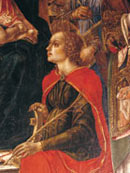 The
Churches in Veli Lošinj mostly feature works of art imported by
Lošinj’s naval captains who bought them at auctions of Venetian
churches. The church of St. Anthony (crkva sv. Antuna) from the
15th century displays the paintings Virgin and Child with Saints by
Bartolomeo Vivarini (1440–1499), St. Francis by Bernard Strozzi
(1581−1644), St. John the Baptist by Lattanzio Querena (1768 – 1853),
Adoration of the Kings by Francesco Hayez (1791−1882), St. Gregory by
Francesco del Cossa (1435−1477) and Souls in the Purgatory by F.
Potenza. The church of Our Lady of the Assumption (crkva Marijina
uzašašća) from 1510 houses the paintings of St. Hildebrand and St.
Francis of Assisi by Francesco Fontebass (1709 – 1769), as well as
several anonymous works from the period between the 16th and 18th
centuries. Lošinj’s maritime character is also reflected in votive
paintings by sailors from the 18th century in the church of St. Nicholas
(crkva sv. Nikole) in Veli Lošinj and those from the 19th century in the
church of Our Lady of the Annunciation (crkva Marijina Navještenja) in
Čikat in Mali Lošinj. The
Churches in Veli Lošinj mostly feature works of art imported by
Lošinj’s naval captains who bought them at auctions of Venetian
churches. The church of St. Anthony (crkva sv. Antuna) from the
15th century displays the paintings Virgin and Child with Saints by
Bartolomeo Vivarini (1440–1499), St. Francis by Bernard Strozzi
(1581−1644), St. John the Baptist by Lattanzio Querena (1768 – 1853),
Adoration of the Kings by Francesco Hayez (1791−1882), St. Gregory by
Francesco del Cossa (1435−1477) and Souls in the Purgatory by F.
Potenza. The church of Our Lady of the Assumption (crkva Marijina
uzašašća) from 1510 houses the paintings of St. Hildebrand and St.
Francis of Assisi by Francesco Fontebass (1709 – 1769), as well as
several anonymous works from the period between the 16th and 18th
centuries. Lošinj’s maritime character is also reflected in votive
paintings by sailors from the 18th century in the church of St. Nicholas
(crkva sv. Nikole) in Veli Lošinj and those from the 19th century in the
church of Our Lady of the Annunciation (crkva Marijina Navještenja) in
Čikat in Mali Lošinj. 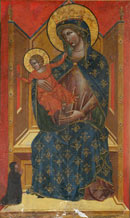 Sacred
painting on the island of Rab includes many valuable pieces of art.
Today’s parish church (until 1828 the Cathedral of St. Mary the Great -
katedrala sv. Marije Velike) hosts an altarpiece (pala) depicting Virgin
and Child from the 14th century, supposedly by Guariento d’Arpo from
Paolo Veneziano’s circle. This church also displays a work of late
Venetian baroque (between 1746 and 1756), The Assumption. The church of
St. Anthony the Abbot (crkva sv. Antuna Opata) includes an altarpiece
(pala) depicting St. Joachim and Anthony, a work by Mateo Ponzoni from
the 17th century. Beside the Benedictine monastery of St. Andrew is a
monastery church built in the mid-11th century. In the northern apse of
the church is a renaissance crucifix with a depiction of Lamentation.
The main altar in the church of St. Andrew contains an altarpiece (pala)
by the Venetian painter A. Novelli from 1765. There is also the valuable
Cretan-Byzantine painting of the Virgin Mary with Christ in her arms
from the 16th century, whose silver-golden icon frame was made by a
Venetian goldsmith in the 18th century. Inside the monastery is a
Cretan-Venetian painting Lamentation of Christ from the 16th century.
The church of St. Justine from 1574 is home to an altarpiece (pala) with
a depiction of St. Justine and characters from the Battle of Lepanto
from the 17th century by a Flemish painter, Baldasare d’Ana. The
altarpiece in the same church with the depiction of Death of St. Joseph
is a work by the Venetian painters’ workshop from the turn of the 16th
and 17th centuries. A polyptych from the ruins of the church of St. John
the Evangelist, with the central composition of the Crucifixion and
figures of the saints (from the 14th century), is credited to the best
painter of the Venetian trecento, Paolo Veneziano. Virgin with Christ in
her arms and the angels is a work by a Spanish painter Zuano Buschet
from the 16th century. The lower part of the altarpiece in the church of
the Holy Cross (crkva sv. Križa) includes a depiction of Virgin with
Christ in her arms and the angels. The painting was credited to several
master painters of the Venetian settecento, most recently to Giovani
Scajara. The church of St. Anthony of Padua hosts an altarpiece (pala)
with the depiction of Virgin with Christ in her arms and the angels by a
Venetian baroque painter from the 17th century. The central building of
the Franciscan monastery of St. Euphemia, the church of St. Bernardine
houses a late Gothic sanctuary and a depicted baroque ceiling of the
naos. The polyptych in the sanctuary with a depiction of the Virgin with
Christ in her arms and the angels is a work by Venetian painters, the
brothers Antonio and Bartolomeo Vivarini (from 1458). Its golden frame
was made by the wood-carver Franciscus. Sacred
painting on the island of Rab includes many valuable pieces of art.
Today’s parish church (until 1828 the Cathedral of St. Mary the Great -
katedrala sv. Marije Velike) hosts an altarpiece (pala) depicting Virgin
and Child from the 14th century, supposedly by Guariento d’Arpo from
Paolo Veneziano’s circle. This church also displays a work of late
Venetian baroque (between 1746 and 1756), The Assumption. The church of
St. Anthony the Abbot (crkva sv. Antuna Opata) includes an altarpiece
(pala) depicting St. Joachim and Anthony, a work by Mateo Ponzoni from
the 17th century. Beside the Benedictine monastery of St. Andrew is a
monastery church built in the mid-11th century. In the northern apse of
the church is a renaissance crucifix with a depiction of Lamentation.
The main altar in the church of St. Andrew contains an altarpiece (pala)
by the Venetian painter A. Novelli from 1765. There is also the valuable
Cretan-Byzantine painting of the Virgin Mary with Christ in her arms
from the 16th century, whose silver-golden icon frame was made by a
Venetian goldsmith in the 18th century. Inside the monastery is a
Cretan-Venetian painting Lamentation of Christ from the 16th century.
The church of St. Justine from 1574 is home to an altarpiece (pala) with
a depiction of St. Justine and characters from the Battle of Lepanto
from the 17th century by a Flemish painter, Baldasare d’Ana. The
altarpiece in the same church with the depiction of Death of St. Joseph
is a work by the Venetian painters’ workshop from the turn of the 16th
and 17th centuries. A polyptych from the ruins of the church of St. John
the Evangelist, with the central composition of the Crucifixion and
figures of the saints (from the 14th century), is credited to the best
painter of the Venetian trecento, Paolo Veneziano. Virgin with Christ in
her arms and the angels is a work by a Spanish painter Zuano Buschet
from the 16th century. The lower part of the altarpiece in the church of
the Holy Cross (crkva sv. Križa) includes a depiction of Virgin with
Christ in her arms and the angels. The painting was credited to several
master painters of the Venetian settecento, most recently to Giovani
Scajara. The church of St. Anthony of Padua hosts an altarpiece (pala)
with the depiction of Virgin with Christ in her arms and the angels by a
Venetian baroque painter from the 17th century. The central building of
the Franciscan monastery of St. Euphemia, the church of St. Bernardine
houses a late Gothic sanctuary and a depicted baroque ceiling of the
naos. The polyptych in the sanctuary with a depiction of the Virgin with
Christ in her arms and the angels is a work by Venetian painters, the
brothers Antonio and Bartolomeo Vivarini (from 1458). Its golden frame
was made by the wood-carver Franciscus.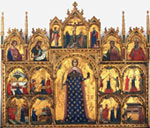 Sacred
painting on the island of Krk has left us many works of art.
Paintings in the cathedral in the town of Krk include: the polyptych St.
Lucy by Paolo Veneziano (after 1333) from the Benedictine abbey in
Jurandvor near Baška, in the diocese as a part of the collection of
works by Italian masters from the 15th and the 16th centuries; The
Entombment by Giovanni Antonio Pordenone (Pordenone, 1483 – Ferrara,
1539); four religious paintings: Manna from Heaven, Abraham’s Sacrifice, Multiplication of Bread and The Last Supper by Christophor Tasca
(Bergamo, 1667 – Venice, 1737) from 1706; three paintings of the
Annunciation St. Francis of Paola, St. Anthony the Abbot and St. John of
Nepomuk with the Holy Bishop by Nicola Grassi (1682 – 1748) from the
period between 1712 and 1721; and finally the large painting of Our Lady
of Carmel by Francesco Zugna (probably from the same period). The altar
painting of Madonna with saints by Bernardino Licinio (Bergamo, around
1489 – after 1561) is located in the single-aisled Franciscan church
from the 12th century (not far from the church of Our Lady of Health -
crkva Gospe od Zdravlja). The three-aisled parish church of Holy Trinity
(crkva Sv. Trojstva) in Baška (from 1722) displays altar paintings of
Our Lady with saints from the end of the 15th century by Marco Marziala
(1492 – 1507) and The Last Supper by Jacopo Palma the Younger (1544 –
1628). The Third Order Franciscan monastery from the 15th century near
the church from the 16th century is located in Glavotok on the west
coast of the island of Krk. The main altar of the church features the
paintings Blessed Virgin Mary and Child, St. Francis and St. Jerome,
presumably by Matteo da Verona (1576 – 1618). The monastery houses
paintings and liturgical items from the 17th and 18th centuries, as well
as several Glagolitic inscriptions. The main altar of the parish church
of the Holy Trinity (crkva sv. Trojstva) from 1777 (reconstructed in
1934) includes carvings and sculptures from the 18th century and the
altarpiece (pala) St. john preaching in the desert by Domeniko Fedeli
called Maggiotto (1713 – 1793). The chapel of the church of St. Mary in
Vrbnik displays the polyptych of St. Ana, a work by a local painter from
the 15th century, and the main altar features the painting The Last
Supper by Marino Cvitković from Kotor (1599). The Dinko Vitezić library
in Vrbnik contains a triptych of the Blessed Virgin Mary with Saints
from the 16th century. A Third Order Franciscan monastery was formed in
Dubašnica next to the small church of St. Mary Magdalene near the
village of Porat around 1480. The church features a polyptych by
Girolamo and Francesco de Santacroce (before 1556), and the monastery
includes a cultural history museum, library and archive with Glagolitic
manuscripts. The church of St. Maria in Gorica includes paintings by
Celestin Medović, (academic Franciscan painter, born in Kuna on the
peninsula of Pelješac in 1857, died in Sarajevo in 1920), a renowned
artist from the first generation of Croatian modernism. Sacred
painting on the island of Krk has left us many works of art.
Paintings in the cathedral in the town of Krk include: the polyptych St.
Lucy by Paolo Veneziano (after 1333) from the Benedictine abbey in
Jurandvor near Baška, in the diocese as a part of the collection of
works by Italian masters from the 15th and the 16th centuries; The
Entombment by Giovanni Antonio Pordenone (Pordenone, 1483 – Ferrara,
1539); four religious paintings: Manna from Heaven, Abraham’s Sacrifice, Multiplication of Bread and The Last Supper by Christophor Tasca
(Bergamo, 1667 – Venice, 1737) from 1706; three paintings of the
Annunciation St. Francis of Paola, St. Anthony the Abbot and St. John of
Nepomuk with the Holy Bishop by Nicola Grassi (1682 – 1748) from the
period between 1712 and 1721; and finally the large painting of Our Lady
of Carmel by Francesco Zugna (probably from the same period). The altar
painting of Madonna with saints by Bernardino Licinio (Bergamo, around
1489 – after 1561) is located in the single-aisled Franciscan church
from the 12th century (not far from the church of Our Lady of Health -
crkva Gospe od Zdravlja). The three-aisled parish church of Holy Trinity
(crkva Sv. Trojstva) in Baška (from 1722) displays altar paintings of
Our Lady with saints from the end of the 15th century by Marco Marziala
(1492 – 1507) and The Last Supper by Jacopo Palma the Younger (1544 –
1628). The Third Order Franciscan monastery from the 15th century near
the church from the 16th century is located in Glavotok on the west
coast of the island of Krk. The main altar of the church features the
paintings Blessed Virgin Mary and Child, St. Francis and St. Jerome,
presumably by Matteo da Verona (1576 – 1618). The monastery houses
paintings and liturgical items from the 17th and 18th centuries, as well
as several Glagolitic inscriptions. The main altar of the parish church
of the Holy Trinity (crkva sv. Trojstva) from 1777 (reconstructed in
1934) includes carvings and sculptures from the 18th century and the
altarpiece (pala) St. john preaching in the desert by Domeniko Fedeli
called Maggiotto (1713 – 1793). The chapel of the church of St. Mary in
Vrbnik displays the polyptych of St. Ana, a work by a local painter from
the 15th century, and the main altar features the painting The Last
Supper by Marino Cvitković from Kotor (1599). The Dinko Vitezić library
in Vrbnik contains a triptych of the Blessed Virgin Mary with Saints
from the 16th century. A Third Order Franciscan monastery was formed in
Dubašnica next to the small church of St. Mary Magdalene near the
village of Porat around 1480. The church features a polyptych by
Girolamo and Francesco de Santacroce (before 1556), and the monastery
includes a cultural history museum, library and archive with Glagolitic
manuscripts. The church of St. Maria in Gorica includes paintings by
Celestin Medović, (academic Franciscan painter, born in Kuna on the
peninsula of Pelješac in 1857, died in Sarajevo in 1920), a renowned
artist from the first generation of Croatian modernism.Public monuments in Rijeka from the 16th until the 19th century include a series of valuable works that chronologically begin in 1508 with a stendarac, an old town flagpole that is today located in front the former Municipium palace. A famous monument to road building, the Pyramid, is a milestone from the beginning of the 19th century erected on its present location of the part of the town of the same name when the road that connects Rijeka to the cove of Martinšćica was constructed in 1833. Of the monumental Emperor Franz Joseph fountain from 1857, today only the figure of the Emperor remains. it is kept in the Rijeka State Archive. Adamićevi svjedoci (Adamić’s witnesses), a work by the stone-carver from Rijeka Giuseppe Capovilla, is now exhibited in the lapidarium of the History and Maritime Museum in Rijeka. Simone Adamich, a tobacco wholesaler from Rijeka, had them made as a warning against perjury at the end of the 18th century. The Basilisk in Trsat Castle, also known as the Trast Dragon, is a zoomorphic mythological creature and a heraldic adornment on the coat of arms of the Nugent family from the end of the 19th century. Two such sculptures were made by the Viennese sculptor Anton Dominik von Fernkorn (1813 – 1878). 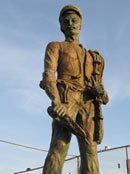 Public
monuments in Rijeka from the second half of the 20th century include
many valuable works of art. A monument to health, a fountain with the
sculpture of Hygia by the sculptor Zvonko Car has been located in the
park of the Rijeka hospital since 1956. The stone bust of Frano Supilo
in front of the building of the local newspaper Novi list is a work by
Julije Csikos Sessija (Zagreb, 1898 – 1978). The fountain in Kobler
square from the 1970s was set up on the 150th anniversary of the paper
factory; its creator was the architect from Rijeka Igor Emili (Sušak,
1927 – Rijeka, 1987). The academic sculptor from Rijeka Vinko Matković
(Sušak, 1911 – Rijeka, 1973) created the grand Monument to the
Liberation in the part of the town called Delta (1955), whose pedestal
contains reliefs by the sculptor Raoul Goldoni (Split, 1919 – Zagreb,
1983). Ljubo de Karina is the creator of the monument to the Fallen
People from Trsat in World War II (1977), and the Altar - Cross in Trsat
cemetery in memory of the fallen soldiers of the Croatian Homeland War
(1998). Works by the sculptor Belizar Bahorić (Sušačka Draga near
Rijeka, 1920 – Zagreb, 2002) are exhibited in several locations: a bust
of the composer and musician Ivan pl. Zajc was placed in the park in
front of Rijeka Theatre in the 1980s; the sculpture of the milkmaid
Mlikarica dates from the 1990s; the Monument to the S Public
monuments in Rijeka from the second half of the 20th century include
many valuable works of art. A monument to health, a fountain with the
sculpture of Hygia by the sculptor Zvonko Car has been located in the
park of the Rijeka hospital since 1956. The stone bust of Frano Supilo
in front of the building of the local newspaper Novi list is a work by
Julije Csikos Sessija (Zagreb, 1898 – 1978). The fountain in Kobler
square from the 1970s was set up on the 150th anniversary of the paper
factory; its creator was the architect from Rijeka Igor Emili (Sušak,
1927 – Rijeka, 1987). The academic sculptor from Rijeka Vinko Matković
(Sušak, 1911 – Rijeka, 1973) created the grand Monument to the
Liberation in the part of the town called Delta (1955), whose pedestal
contains reliefs by the sculptor Raoul Goldoni (Split, 1919 – Zagreb,
1983). Ljubo de Karina is the creator of the monument to the Fallen
People from Trsat in World War II (1977), and the Altar - Cross in Trsat
cemetery in memory of the fallen soldiers of the Croatian Homeland War
(1998). Works by the sculptor Belizar Bahorić (Sušačka Draga near
Rijeka, 1920 – Zagreb, 2002) are exhibited in several locations: a bust
of the composer and musician Ivan pl. Zajc was placed in the park in
front of Rijeka Theatre in the 1980s; the sculpture of the milkmaid
Mlikarica dates from the 1990s; the Monument to the S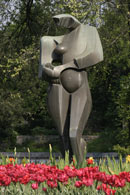 portsman
is located at the sports ground of the Orijent football club, and the
sculpture Val (The Wave) on the square in front of the Town Library
(2004). The monument to Rijeka’s poet and writer Janko Polić Kamov
(Sušak, 1890 – Barcelona, 1910) is a work of the academic sculptor
Zvonimir Kamenar from 2000 and is located along the fence of the old
Sušak bridge near the Hotel Kontinental. Kamenar’s works also include
the sculpture in memory of the Fallen soldiers of Kostrena in World War
II (1976) and the stone monument to the victims of the Homeland War in
Croatia at the 3. maj shipyard in Rijeka. At the eastern entrance to the
town (the so-called Plumbum) is a lantern – a monument to friendship – a
gift from the town of Kawasaki to Rijeka in 1986. Jelačić square
contains Kawasaki, a fountain by the architect Abel Šlosar (Opatija,
1939 – Volosko, 2005) and Maša Uravić from the 1980s, with a sculpture
that was donated by the town of Kawasaki. The sculpture Majčinstvo
(Motherhood, from 1979) by the academic sculptress Jasna Bogdanović from
1979 is located at the entrance to the Institute for Public Health
(Zavod za javno zdravstvo). The monument to Pope John Paul II called
The
Trsat Pilgrim (Trsatski hodočasnik) from 2005 by Ante Jurkić, an
academic sculptor from Zagreb, is located in Mary’s gardens (Marijin
perivoj) of Trsat church. portsman
is located at the sports ground of the Orijent football club, and the
sculpture Val (The Wave) on the square in front of the Town Library
(2004). The monument to Rijeka’s poet and writer Janko Polić Kamov
(Sušak, 1890 – Barcelona, 1910) is a work of the academic sculptor
Zvonimir Kamenar from 2000 and is located along the fence of the old
Sušak bridge near the Hotel Kontinental. Kamenar’s works also include
the sculpture in memory of the Fallen soldiers of Kostrena in World War
II (1976) and the stone monument to the victims of the Homeland War in
Croatia at the 3. maj shipyard in Rijeka. At the eastern entrance to the
town (the so-called Plumbum) is a lantern – a monument to friendship – a
gift from the town of Kawasaki to Rijeka in 1986. Jelačić square
contains Kawasaki, a fountain by the architect Abel Šlosar (Opatija,
1939 – Volosko, 2005) and Maša Uravić from the 1980s, with a sculpture
that was donated by the town of Kawasaki. The sculpture Majčinstvo
(Motherhood, from 1979) by the academic sculptress Jasna Bogdanović from
1979 is located at the entrance to the Institute for Public Health
(Zavod za javno zdravstvo). The monument to Pope John Paul II called
The
Trsat Pilgrim (Trsatski hodočasnik) from 2005 by Ante Jurkić, an
academic sculptor from Zagreb, is located in Mary’s gardens (Marijin
perivoj) of Trsat church. 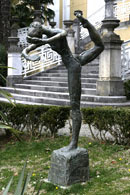 Public
monuments on the Opatija Riviera are often typified by the sculpture
Girl with the Seagull, one of the visual symbols of Opatija, created in
1956 by Zvonko Car. It is located on the same rock above the sea near
the former cemetery on which previously stood the sculpture Madonna del
Mare by Hans Rathausky from Graz, who was also creator of the Helios and
Selene fountain from 1889 in the park between the church of St. James
(crkva sv. Jakova) and the Hotel Imperial. A gilded replica of the
Madonna now stands in front of the church of St. James. A series of
sculptures by Tatjana Kostanjević (born in 1963 in Rijeka) points to
some of Opatija’s more famous visitors, like the ballet dancer Isadora
Duncan (2002) and the writer A.P. Chekhov (2003) in Angiolina Park, and
the composer Gustav Mahler (2004) in front of the Villa Jeanette. A
relief portrait of Dr. Čedomil Plavšić (1902 – 1987, founder and for
many years director of the Thalassotherapia, is exhibited in the
Thalassotherapia building (2005). The creator of the vertical wooden
sculpture from the 1990s, Without Title, located in front of Opatija
Town Hall, is Mirko Zrinšćak (born 1953 in Volosko). He was the first
artist from Liburnia to represent Croatia at the Biennale in Venice, in
1995. The façade of the Town Hall (2002) features a bronze bust of the
Croatian patriot and politician Dr. Andrija Štanger (Volosko, 1853 –
1934) who was head of the Volosko – Opatija Municipality from 1895 until
1918. The bust was created by the sculptor Ivan Rendić (Imotski, 1849 –
Split, 1932), and the pedestal was made by Ljubo de Karina. In front of
the Zora Cultural Society (Kulturni dom Zora) in Opatija is the
sculpture Nordkapp by Siniša Majkus (born in Rijeka in 1962). His work
Linné from 1998 is exhibited in Matulji. Public
monuments on the Opatija Riviera are often typified by the sculpture
Girl with the Seagull, one of the visual symbols of Opatija, created in
1956 by Zvonko Car. It is located on the same rock above the sea near
the former cemetery on which previously stood the sculpture Madonna del
Mare by Hans Rathausky from Graz, who was also creator of the Helios and
Selene fountain from 1889 in the park between the church of St. James
(crkva sv. Jakova) and the Hotel Imperial. A gilded replica of the
Madonna now stands in front of the church of St. James. A series of
sculptures by Tatjana Kostanjević (born in 1963 in Rijeka) points to
some of Opatija’s more famous visitors, like the ballet dancer Isadora
Duncan (2002) and the writer A.P. Chekhov (2003) in Angiolina Park, and
the composer Gustav Mahler (2004) in front of the Villa Jeanette. A
relief portrait of Dr. Čedomil Plavšić (1902 – 1987, founder and for
many years director of the Thalassotherapia, is exhibited in the
Thalassotherapia building (2005). The creator of the vertical wooden
sculpture from the 1990s, Without Title, located in front of Opatija
Town Hall, is Mirko Zrinšćak (born 1953 in Volosko). He was the first
artist from Liburnia to represent Croatia at the Biennale in Venice, in
1995. The façade of the Town Hall (2002) features a bronze bust of the
Croatian patriot and politician Dr. Andrija Štanger (Volosko, 1853 –
1934) who was head of the Volosko – Opatija Municipality from 1895 until
1918. The bust was created by the sculptor Ivan Rendić (Imotski, 1849 –
Split, 1932), and the pedestal was made by Ljubo de Karina. In front of
the Zora Cultural Society (Kulturni dom Zora) in Opatija is the
sculpture Nordkapp by Siniša Majkus (born in Rijeka in 1962). His work
Linné from 1998 is exhibited in Matulji.Public monuments in the Vinodol region include various works by Zvonko Car in Crikvenica. The park of the Hotel Kaštel features a monument to the writer Vladimir Nazor by Zdenko Kolacio (architect and town planner, Sušak, 1914 – Zagreb, 1987) and the stone sculpture of St. John the Nepomuk from 1735, restored in 1980 by the sculptor Zvonimir Kamenar. Monuments to Julije Klović, a great artist from our region, are exhibited in Drivenik and Grižane. The monument in Drivenik is a work of Zvonko Car and is located in front of the old primary school, while the monument in Grižane is a medallion with the figure of the painter, a work by Ivan Belobrajić (Tribalj, 1933). The same village hosts a monument to fallen soldiers by Vinko Matković and the sculpture Woman with a Wooden Basket by Zvonko Car. The bust of Mihovil Kombol in Bribir is a work by Drago Čarapina. Mosaic Selčanka (Woman from Selce - around 1958) by Hajrudin Kujundžić (Velečevo/Bosnia and Herzegowina, 1915 – Zagreb, 1986) is located above the Polača spring, and his frescos The last farewell and The sentry can be seen at the partisan memorial cemetery. The author is also the founder of the Toč gallery in Selce. 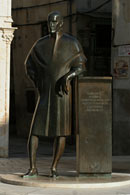 Public
monuments on the island of Cres serve as reminders of some of the
great personalities of Croatian and worldwide culture who were born on
this island. In 1997 Marija Ujević-Galetović, academic sculptor from
Zagreb (1933) and member of the Croatian Academy of Sciences and Arts
(HAZU, since 1998), erected a monument to Franjo Petrić (Cres, 25th
April 1529 – Rome, 6th/7th February 1597), a philosopher, poet and
historian interested in military disciplines, mathematics, geometry and
medicine. His works include Sretan grad, Rasprave o peripatetičkoj
filozofiji, Nova opća filozofija. The sculpture is located in front of
Arsan Palace, the house in which Petrić was born. Sculptor Ljubo de
Karina is the creator of 20 stone sculptures along the Tramuntana I
eco-path (1996/98). The path is dedicated to Andro Vid Mihičić (Beli,
1896 – Mali Lošinj, 1992), poet, art historian, collector, donor and
professor on the Academy of Visual Arts in Zagreb. He has published
several books: About the sculptor Dujmo Penić, Paris 1930; Sonde i Stope
u prahu, Beli, 1988; Kucanje na vratima tajne and Prividi i slutnje,
1990/91. Along the access road to Valun, a stone sculpture Stol (Table)
was placed in 1999, in the same location as the grave monument to Msgr.
Anton Benvin, rector of St. Jerome’s in Rome. Public
monuments on the island of Cres serve as reminders of some of the
great personalities of Croatian and worldwide culture who were born on
this island. In 1997 Marija Ujević-Galetović, academic sculptor from
Zagreb (1933) and member of the Croatian Academy of Sciences and Arts
(HAZU, since 1998), erected a monument to Franjo Petrić (Cres, 25th
April 1529 – Rome, 6th/7th February 1597), a philosopher, poet and
historian interested in military disciplines, mathematics, geometry and
medicine. His works include Sretan grad, Rasprave o peripatetičkoj
filozofiji, Nova opća filozofija. The sculpture is located in front of
Arsan Palace, the house in which Petrić was born. Sculptor Ljubo de
Karina is the creator of 20 stone sculptures along the Tramuntana I
eco-path (1996/98). The path is dedicated to Andro Vid Mihičić (Beli,
1896 – Mali Lošinj, 1992), poet, art historian, collector, donor and
professor on the Academy of Visual Arts in Zagreb. He has published
several books: About the sculptor Dujmo Penić, Paris 1930; Sonde i Stope
u prahu, Beli, 1988; Kucanje na vratima tajne and Prividi i slutnje,
1990/91. Along the access road to Valun, a stone sculpture Stol (Table)
was placed in 1999, in the same location as the grave monument to Msgr.
Anton Benvin, rector of St. Jerome’s in Rome.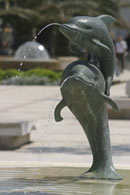 Public
monuments on the island of Lošinj include a park of sculptures with
musical motifs called Sculpture and Music in Osor. It includes works by
Ivan Meštrović, Fran Kršinić, Vanja Radauš, Toma Rosandić and Marija
Ujević. The park features an outstanding sculpture of the composer Jakov
Gotovac by the sculptress Marija Ujević-Galetović. In 1998 the sculptor
Belizar Bahorić created the Monument to the Croatian Kuna (Spomenik
hrvatskoj kuni), a currency which was first mentioned in Osor in 1018.
Sculptor Vinko Matković created the fountain Monument to Water (Spomenik
vodi) in 1960. It is located on the Republic of Croatia Square in Mali
Lošinj and features a fountain with sculptures of two dolphins that has
become the symbol of Lošinj. The same square also displays the monument
to a spear fisher by Ante Starčević that was made according to the
original by Vinko Matković. Ante Starčević, academic sculptor from
Zagreb (1933), made in 1980 the monument to Ambroz Haračić that is
located in the bay of Čikat. Haračić (1855 – 1916) conducted
meteorological measurements, initiated the afforestation of the island,
was founder of the first tourism society in 1886 and is considered the
person who has done most for the development of tourism on the island.
The academic sculptor Dušan Džamonja (Strumica / Macedonia, 1928) made
the Monument to a Sailor (Spomenik mornaru) in 1956; it is located in
Velopin and dedicated to the liberators of the islands of Cres and
Lošinj in World War II. Public
monuments on the island of Lošinj include a park of sculptures with
musical motifs called Sculpture and Music in Osor. It includes works by
Ivan Meštrović, Fran Kršinić, Vanja Radauš, Toma Rosandić and Marija
Ujević. The park features an outstanding sculpture of the composer Jakov
Gotovac by the sculptress Marija Ujević-Galetović. In 1998 the sculptor
Belizar Bahorić created the Monument to the Croatian Kuna (Spomenik
hrvatskoj kuni), a currency which was first mentioned in Osor in 1018.
Sculptor Vinko Matković created the fountain Monument to Water (Spomenik
vodi) in 1960. It is located on the Republic of Croatia Square in Mali
Lošinj and features a fountain with sculptures of two dolphins that has
become the symbol of Lošinj. The same square also displays the monument
to a spear fisher by Ante Starčević that was made according to the
original by Vinko Matković. Ante Starčević, academic sculptor from
Zagreb (1933), made in 1980 the monument to Ambroz Haračić that is
located in the bay of Čikat. Haračić (1855 – 1916) conducted
meteorological measurements, initiated the afforestation of the island,
was founder of the first tourism society in 1886 and is considered the
person who has done most for the development of tourism on the island.
The academic sculptor Dušan Džamonja (Strumica / Macedonia, 1928) made
the Monument to a Sailor (Spomenik mornaru) in 1956; it is located in
Velopin and dedicated to the liberators of the islands of Cres and
Lošinj in World War II.Public monuments on the island of Rab include a very special gift: the fountain in the Boškopini park was given to Rab at the end of the 1930s by the ban (governor) Ivan Perović. The fountain has six sources of water that symbolise the parishes of the island with a common source in the centre. The fountain in St. Christopher’s Square (Trg sv. Kristofora), a work of the academic sculptor Žarko Violić from Rijeka (1989), portrays the local legend of the shepherdess Draga and Kalifront from an epic by Juraj Baraković. The memorial cemetery for the victims of fascism in Kampor from 1953 is a project by Slovenian architect Edvard Ravnikar (1907-1993). The memorial complex includes a mosaic by Marijo Pregelj from Slovenia. The monument to the fallen soldiers of World War II is a work by Vinko Matković from 1952. It has been restored in 2003 and joined with the monument to the fallen soldiers and victims of the Homeland war in Croatia by Mladen Šćerbe. It is located in the town’s Boškopini Park. The bust of Pravdoje Belija (highly esteemed senior forester of Rab, 1853 – 1923) was put up in 1974 in the town’s Komrčar Park. The sculptor is unknown. The bronze statue of St. Marin by Daniella Volpini from San Marino (2004) is a gift to Rab from the Republic of San Marino. The bronze monument to Markantunus de Dominis (archbishop, mathematician and physicist, born in Rab, 1560, died in Rome, 1624, as a prisoner of the Inquisition) is a work by Kosta Angeli Radovani (academic painter, London, 1916 – Zagreb, 2002) from 1974. The monument was placed in front of Dominis’s house of birth in 1994. 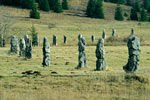 The
bust of Ivan Goran Kovačić and the monument in the meadow of Matić
poljana are the most valuable recent public monuments in Gorski kotar.
The bust of the poet Ivan Goran Kovačić (Lukovdol 1913 – Bunovo 1943) is
located next to the house in which he was born. It was made by Vojin
Bakić (academic sculptor, Bjelovar, 1915 – Zagreb, 1992) in 1946 and is
one of the author’s most important works. On the northern part of the
meadow of Matić poljana near Mrkopalj is a monument to the tragic death
of 26 partisans who froze to death in that meadow on 19th/20th of
February 1944. The monument consists of a row of stone blocks put into
the ground. The
bust of Ivan Goran Kovačić and the monument in the meadow of Matić
poljana are the most valuable recent public monuments in Gorski kotar.
The bust of the poet Ivan Goran Kovačić (Lukovdol 1913 – Bunovo 1943) is
located next to the house in which he was born. It was made by Vojin
Bakić (academic sculptor, Bjelovar, 1915 – Zagreb, 1992) in 1946 and is
one of the author’s most important works. On the northern part of the
meadow of Matić poljana near Mrkopalj is a monument to the tragic death
of 26 partisans who froze to death in that meadow on 19th/20th of
February 1944. The monument consists of a row of stone blocks put into
the ground.Zvonko Car, academic sculptor, teacher and public worker (1913 – 1982, died in his hometown of Crikvenica), was a very busy sculptor in his native region. He created a stone statue of the Blessed Virgin Mary in front of the parish church of Our Lady of the Assumption, and a travertine statue of St. Anthony in the church of the same name (crkva sv. Antuna). A bronze bust of Stjepan Radić (1940) is located at the entrance to the park, which also has a bust of Dr. Ivan Sobol. There is a bronze bust of the writer Vladimir Nazor in front of the primary school, and a bust of Dr. Antun Barac in the building of the secondary school. A replica of the bust of Josip Pančić (1986) is located in front of the Hotel Omorika, and the sculpture Fisher (Ribar) is in Crikvenica’s harbour. Car also created the monument to fallen soldiers in Selce. In the centre of Selce are busts of revolutionaries and fighters from World War II. Collections in Novi Vinodolski and Selce include valuable exhibits. On the ground floor of the Frankopan family castle in Novi Vinodolski (from 1288) is the Public Reading Room and Library from the period of the so-called Illyrian revival (1845), founded by Josip Mažuranić. The second floor contains the People’s Museum with archive material dating from 1288 until today. It includes an ethnographic collection, a collection of archaeological and hydro-archaeological finds from the area of Novi Vinodolski and Povile, a collection of arts and weapons, and a Mažuranić memorial collection. The collection of the Public Reading Room and Library in Selce includes manuscripts and paintings by Ivan Lončarić Papić (Selce, 1870 – 1964), chronicler, poet, archivist, writer, painter and encyclopaedist. Selce also has the Stara škola (Old school) gallery that is run by the by Lirac’s painters’ workshop. The parish church in the town of Cres (from the 15th century) has one of the most valuable paintings from that area, created by the painter Alvise Vivarini (Venice, ca. 1445/46 – 1503/05) with the central figure of St. Sebastian. The Town of Cres Museum houses monuments of artistic, cultural and historical importance for the island. The Prehistory and Ancient Archaeology collections include wicker sculptures, icons, wooden items from the 15th century and numismatics. The collection of stone monuments - the lapidarium - includes roman inscriptions from the northern part of the island and medieval epigraphy. The collection in the parish church includes paintings from the period between the 15th and 18th centuries; the Franciscan monastery presents a collection of furniture from the 16th and 17th centuries, Gothic plastic arts, paintings, incunabula and codices from the 15th century; and the Benedictine monastery is home to icons and codices from the 15th century. People’s college (Pučko učilište) Mali Lošinj includes two valuable collections. The first is the collection that was donated in 1988 by Andro Vid Mihičić (Beli, 1896 – Mali Lošinj, 1992, scientist, poet, art historian) and includes his manuscripts and works by Kršinić, Vidović, Augustinčić, Radauš, Kerdić, Krstulović, Bošnjak, Janeš, Meštrović, Motika, Aralica, Filakovac, Mujadžić, V. Parać. The second is the Piperat collection of old masters including 27 paintings and some wooden items of artistic utility value. Particularly valuable are the collections of paintings by Italian, French and Dutch 17th and 18th century masters. Ljubo de Karina’s house and gallery displays over 200 works by this academic sculptor (born in Rijeka in 1948) in renovated indigenous stone houses in the hinterland of Brseč (Brsečko Zagorje). Besides the museum of Brseč, his works include the Old town gate in Brseč, a bronze bust of the writer Eugen Kumičić (from 1971), the front door of the church of the Holy Cross (crkvica sv. Križa) from 1995, the stone gutter in the olive mill and the monument to the olive from 1997, the tomb of the archbishop Msgr. Dr. Josip Uhač from 1998, sculptures made of natural stone in the interior of Gallery K in Eugen Kumičić’s birthplace, the bronze rock representing a theme from a novel by Kumičić (2000), and a sculpture from the cycle Stone on Stone (Kamen na kamen) at the crossroads in Brseč (2001). The park in front of the Eugen Kumičić Gymnasium in Opatija (1988) includes his bust of the poet Drago Gervais (writer, Opatija, 1904 – Sežana, 1957). Stone sculptures from the cycle Stone on stone (Kamen na kamen, 1989) and Breakthrough (Prodori, 1990) and a monument to the fallen soldiers of Croatia’s Homeland War are also exhibited in Opatija. De Karina’s bust of Viktor Car Emin (writer, Kraj near Lovran, 1870 – Opatija, 1963) is exhibited in Lovran, in the park in front of the elementary school (1984), and his stone sculpture from 1998 The Cross (Križ) dedicated to St. John the Baptist and the third millennium is located in Jurdani near Matulji . 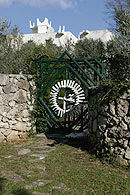 Mate
Solis’s house and gallery (Cres, 1935) is a specific work of art by
the academic painter and sculptor who always remained faithful to the
island of his birth. The gallery is located in Cres and houses a
permanent exhibition. Solis took part in the realisation of the island’s
land use plans, detailed urbanistic plans for individual settlements on
the island, decided on the colours of the facades of old and new
buildings in collaboration with the institute for the protection of
historic monuments, participated in discovering archaeological sites and
their protection, and in choosing projects for public buildings. He
initiated the permanent exhibition in Cres Museum, worked as a teacher,
created the Mate Solis’s Gallery with a permanent exhibition of his
works, and a new gallery in his house with a retrospective collection of
his works from the early 1960s up to the present day. The new gallery
includes a park of sculptures, structures and art installations with an
ethnographical and ecological horticultural garden on an area of 2,400
square metres called AXIS MUNDI. He created the Monument to the fallen
soldiers of World War II (1975) on the promenade in Cres, and designed
the pharmacies in Cres, Mali Lošinj and Nerezine. His decorations and
frescoes are exhibited in the hotels Punta in Veli Lošinj, Kimen in Cres
and Vespera in Mali Lošinj. Mate
Solis’s house and gallery (Cres, 1935) is a specific work of art by
the academic painter and sculptor who always remained faithful to the
island of his birth. The gallery is located in Cres and houses a
permanent exhibition. Solis took part in the realisation of the island’s
land use plans, detailed urbanistic plans for individual settlements on
the island, decided on the colours of the facades of old and new
buildings in collaboration with the institute for the protection of
historic monuments, participated in discovering archaeological sites and
their protection, and in choosing projects for public buildings. He
initiated the permanent exhibition in Cres Museum, worked as a teacher,
created the Mate Solis’s Gallery with a permanent exhibition of his
works, and a new gallery in his house with a retrospective collection of
his works from the early 1960s up to the present day. The new gallery
includes a park of sculptures, structures and art installations with an
ethnographical and ecological horticultural garden on an area of 2,400
square metres called AXIS MUNDI. He created the Monument to the fallen
soldiers of World War II (1975) on the promenade in Cres, and designed
the pharmacies in Cres, Mali Lošinj and Nerezine. His decorations and
frescoes are exhibited in the hotels Punta in Veli Lošinj, Kimen in Cres
and Vespera in Mali Lošinj.The Town of Rijeka Museum (Muzej Grada Rijeke), established on the 11th April 1994, is located in a building that was constructed in 1976 in the courtyard of the Governor’s Palace. It is the venue in which museum materials are processed under expert and scientific supervision, and where collections are systematised and presented to the public. It includes eleven collections: visual arts, art craftsmanship, documentary material, numismatics, securities, medals, weapons and items from World War II and the Homeland War, a collection of theatre and film material, philately, photographs and press cuttings, a technical and a miscellaneous collection. The museum has no permanent exhibition, but the collections are available to visitors and researchers. History and Maritime Museum in Rijeka (Pomorski i povijesni muzej Hrvatskog primorja Rijeka) is the successor of the Museo civico – the Town Museum from the 19th century and the Town Museum of Sušak from 1934. In 1951, the two museums were united into one that has changed several names and that has borne its present name since 1961 and is located in the Governor’s Palace. A rich museum fund encompasses archaeological, maritime, ethnographical, cultural and historical materials. It is interesting to mention that the impulse for the development of museums in Rijeka was given by the Emperor Franz Joseph I – he donated a glass to the town of Rijeka and expressed a wish that it should be kept in a town museum. The Museum of Modern Arts (Muzej moderne i suvremene umjetnosti) in Rijeka has existed since 1948 as a museum and gallery institution. It keeps works by the 19th century artists from Rijeka and Croatian and foreign artists from the 20th and 21st centuries. Due to the lack of adequate exhibition area, there is no permanent museum exhibition. Works from individual collections are occasionally lent to various exhibitions. The Museum organises individual and group exhibitions by Croatian and international authors, researches and organises retrospectives of less-known Croatian artists, and introduces young artists and contemporary Croatian artists abroad. |
|
|
|
|||||
 THE KVARNER COUNTY TOURISM OFFICE 51410 Opatija, Nikole Tesle 2, tel: +385/51/272-988, fax: +385/51/272-909 http://www.kvarner.hr, e-mail:kvarner@kvarner.hr |
|||||